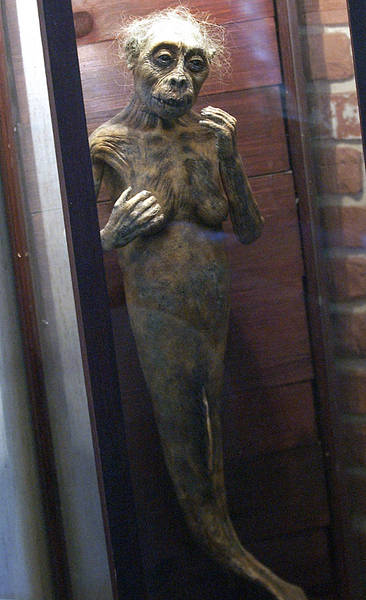
September 8, 2011
Even the Time Warner Cable guy asked during 2011: “How many FeeJee Mermaids do you have in your museum?”
Easy answer: “Two full-scale ones; two mini-replicas!”

Credit: Amber Waterman/Sun Journal.
A movie prop from the 1999 A&E movie P.T. Barnum depicts the FeeJee mermaid, and is part of the International Cryptozoology Museum. Erik Gosselin of Quebec created this wonder for the film, which starred Beau Bridges (below), the older brother of True Grit and Tron actor Jeff Bridges.
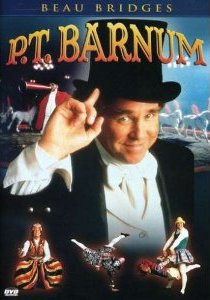

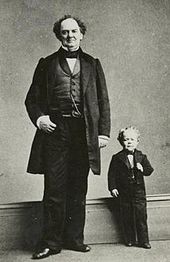
The real Barnum with Commodore Nutt,
photograph by Charles DeForest Fredricks.
Amazingly, most young people coming into the International Cryptozoology Museum have little idea as to whom Barnum is or was. Oftentimes, parents say, “Don’t you remember the Barnum and Bailey circus we went to? He was one of the people who started it.”
Of course, Phineas Taylor Barnum (July 5, 1810 – April 7, 1891) was an American showman, businessman, and entertainer, remembered for promoting celebrated hoaxes and for founding the circus that became the Ringling Bros. and Barnum & Bailey Circus.
On October 20, 2005, on the anniversary of the Patterson-Gimlin footage, after a spate of then current news items quoting me about the Bigfoot “Duel Masters” bounty morphing into a safer, secure photo contest, a Midwestern individual wrote to a Bigfoot email list, taking me to task for getting involved in such a misadventure, and saying, with disgust: “It has been my gut feeling that Loren has the PT Barnum approach to the field of BF.”
This was said with the usual back-biting that happens inside the private talk that occurs within “Bigfoot studies” circles, and although I am used to it, that’s not to say I’m not listening. With sensitivity on my sleeve, my initial defensive feelings were that I do much to calmly and straightforwardly promote Bigfoot and other cryptids. It seems some people get it, some don’t.
At the 2005 Bates conference, many of the speakers discussed Phineas Taylor Barnum with a new understanding, new insights, and new respect. P. T. Barnum was the first, in a purely American tradition, who re-invented the “museum” for North Americans, with insights into what we wanted, not what was merely a carbon copy of the European style of exhibitions. The weekend’s talks given by cryptonaturalist and artist Mark Dion, painter Sean Foley, museum curator Mark Bessire (who today is the director of the Portland Museum of Art), and comments by others, assisted in re-framing Barnum for me.
I have to say I’m now rather proud to be called a “Barnum.” If that’s what it takes to popularize cryptozoology and allows it to grow on one path that opens doors and gets everything from interested students inside to more funding available for future pursuits, great. If Bates’ and Kansas City, Missouri’s traveling Cryptozoology exhibition of 2005-2006 preserved the field’s history and its overlap with art, and my cryptozoology museum collects the artifacts of the quest for the future, even in a Barnum-style, so that tangible pieces of the quest may be shared for people to see, so much the better.
The International Cryptozoology Museum today owns the closest scale model to the actual first FeeJee Mermaid brought to America by Barnum (shown at the beginning of this posting), which measures nearly four feet in height. It depicts that exact FeeJee Mermaid first exhibited by Barnum in 1842 in New York City, and destroyed in the fire of the 1860s (fictionally shown in Gangs of New York). Erik Gosselin creation is unique, that should not be forgotten, and it can only be seen in Portland, Maine, today.
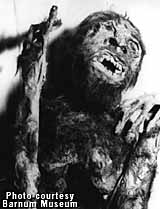
Credit: Roadside America
Even the Barnum Museum in Bridgeport, Connecticut, only has a vague reproduction (shown above). The Fejee mermaid replica there was created by artist Stanton Kip Miller for an HBO TV special on P.T. Barnum, based on original drawings and written descriptions.
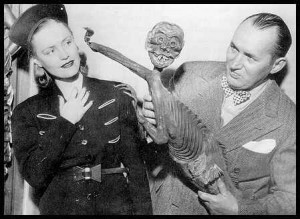
Credit: Ripley’s Believe It Or Not! Museum
The Ripley’s in Florida, and other museums around the country, have smaller, modern 20th century replicas too (Ripley’s above, ICM’s below).

A comment worth repeating from tropicalwolf:
“Anyone who thinks Mr Coleman is in this field for reasons other than legitimate research obviously have not read any of his books or listened to anything he has ever said. Anyone suggesting Mr. Coleman is ‘just a showman’ trying to capitalize on cryptozoology is quite simply a fool. There, I said it, I stand behind it, and I will back up my opinion if necessary. Petty backbiting is for the jealous and/or ignorant. Odds are those who would say those things about Mr. Coleman (who, from my understanding, has dedicated MUCH personal expense to this research) are both.”
About Loren Coleman
Loren Coleman is one of the world’s leading cryptozoologists, some say “the” leading living cryptozoologist. Certainly, he is acknowledged as the current living American researcher and writer who has most popularized cryptozoology in the late 20th and early 21st centuries.
Starting his fieldwork and investigations in 1960, after traveling and trekking extensively in pursuit of cryptozoological mysteries, Coleman began writing to share his experiences in 1969. An honorary member of Ivan T. Sanderson’s Society for the Investigation of the Unexplained in the 1970s, Coleman has been bestowed with similar honorary memberships of the North Idaho College Cryptozoology Club in 1983, and in subsequent years, that of the British Columbia Scientific Cryptozoology Club, CryptoSafari International, and other international organizations. He was also a Life Member and Benefactor of the International Society of Cryptozoology (now-defunct).
Loren Coleman’s daily blog, as a member of the Cryptomundo Team, served as an ongoing avenue of communication for the ever-growing body of cryptozoo news from 2005 through 2013. He returned as an infrequent contributor beginning Halloween week of 2015.
Coleman is the founder in 2003, and current director of the International Cryptozoology Museum in Portland, Maine.
Filed under Artifacts, Cryptomundo Exclusive, Cryptotourism, CryptoZoo News, Evidence, Hoaxes, Media Appearances, Men in Cryptozoology, Merbeings, Museums, Pop Culture, Replica Cryptia, Reviews